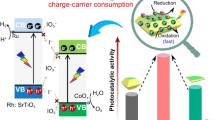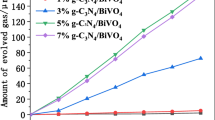Abstract
A 2D Z-scheme BiVO4/g-C3N4 photocatalyst was successfully synthesized by a two-step hydrothermal/calcination method for overall water splitting. Morphology design to restrain the growth of BiVO4 nanoplates with thickness around 20 nm was achieved by adjusting the pH value and introducing graphene sheets. Then, the BiVO4/g-C3N4 (BVO-CN) hybrid photocatalysts were fabricated with different mass ratios of two components. The structures and optical properties of the BVO-CN photocatalysts were characterized by transmission electron microscope, scanning electron microscope, X-ray diffraction, X-ray photoelectron spectroscopy, Fourier transform infrared spectroscopy, ultraviolet–visible spectroscopy, and photoluminescence spectroscopy. In application, the BVO-CN photocatalysts exhibited the catalytic overall water splitting activity up to 15.6 μmol h−1 for H2 production and 7.3 μmol h−1 for O2 evolution under visible light irradiation. A possible Z-scheme mechanism is proposed for the enhanced photocatalytic activity and was further confirmed by electron spin resonance spectroscopy. This study demonstrated enhanced overall water splitting photocatalytic performance of BiVO4/g-C3N4 photocatalyst by constructing a 2D nanoplates morphology and shed light on the morphology design of Z-scheme semiconductor materials.



Similar content being viewed by others
References
Hisatomi T, Kubota J, Domen K (2014) Recent advances in semiconductors for photocatalytic and photoelectrochemical water splitting. Chem Soc Rev 43(22):7520–7535
Linic S, Christopher P, Ingram DB (2011) Plasmonic-metal nanostructures for efficient conversion of solar to chemical energy. Nat Mater 10:911–921
Kamat PV (2007) Meeting the clean energy demand: nanostructure architectures for solar energy conversion. J Phys Chem C 111(7):2834–2860
Serpone N, Emeline AV, Ryabchuk VK, Kuznetsov VN, Artem’ev YM, Horikoshi S (2016) Why do hydrogen and oxygen yields from semiconductor-based photocatalyzed water splitting remain disappointingly low? Intrinsic and extrinsic factors impacting surface redox reactions. ACS Energy Lett 1(5):931–948
Meng J, Lan ZY, Lin QY, Chen T, Chen X, Wei X, Lu YH, Li JX, Zhang Z (2019) Cubic-like BaZrO3 nanocrystals with exposed 001}/{011 facets and tuned electronic band structure for enhanced photocatalytic hydrogen production. J Mater Sci 54(3):1967–1976. https://doi.org/10.1007/s10853-018-2995-8
Ran JR, Zhang J, Yu JG, Jaroniec M, Qiao SZ (2014) Earth-abundant cocatalysts for semiconductor-based photocatalytic water splitting. Chem Soc Rev 43(22):7787–7812
Moniz SJA, Shevlin SA, Martin DJ, Guo ZX, Tang JW (2015) Visible-light driven heterojunction photocatalysts for water splitting—a critical review. Energy Environ Sci 8(3):731–759
Wei Y, Wang J, Yu R, Wan J, Wang D (2019) Constructing SrTiO3–TiO2 heterogeneous hollow multi-shelled structures for enhanced solar water splitting. Angew Chem Int Ed 58(5):1422–1426
Kudo A, Miseki Y (2009) Heterogeneous photocatalyst materials for water splitting. Chem Soc Rev 38(1):253–278
Kumar P, Boukherroub R, Shankar K (2018) Sunlight-driven water-splitting using two-dimensional carbon based semiconductors. J Mater Chem A 6(27):12876–12931
Lee DK, Choi K-S (2018) Enhancing long-term photostability of BiVO4 photoanodes for solar water splitting by tuning electrolyte composition. Nat Energy 3(1):53–60
Kuang YB, Jia QX, Nishiyama H, Yamada T, Kudo A, Domen K (2016) A front-illuminated nanostructured transparent BiVO4 photoanode for > 2% efficient water splitting. Adv Energy Mater 6(2):1501645(1–7)
Jing Q, Feng X, Pan J, Chen L, Liu Y (2018) Facile synthesis of Bi/BiVO4 composite ellipsoids with high photocatalytic activity. Dalton Trans 47(8):2602–2609
Seabold JA, Zhu K, Neale NR (2014) Efficient solar photoelectrolysis by nanoporous Mo:BiVO4 through controlled electron transport. Phys Chem Chem Phys 16(3):1121–1131
Zhong DK, Choi S, Gamelin DR (2011) Near-complete suppression of surface recombination in solar photoelectrolysis by “Co–Pi” catalyst-modified W:BiVO4. J Am Chem Soc 133(45):18370–18377
Li J, Wu N (2014) Semiconductor-based photocatalysts and photoelectrochemical cells for solar fuel generation: a review. Catal Sci Technol 4(12):4440
Wei Y, Li H, Zhang R, Xie H, Chen X (2018) Z-scheme CuFe2O4–TiO2 nanocomposite microspheres for the photodegradation of methylene blue. Res Chem Intermed 44(11):7107–7116
Zhou P, Yu J, Jaroniec M (2014) All-solid-state Z-scheme photocatalytic systems. Adv Mater 26(29):4920–4935
Wang X, Maeda K, Thomas A, Takanabe K, Xin G, Carlsson JM, Domen K, Antonietti M (2008) A metal-free polymeric photocatalyst for hydrogen production from water under visible light. Nat Mater 8:76–80
Godin R, Wang Y, Zwijnenburg MA, Tang J, Durrant JR (2017) Time-resolved spectroscopic investigation of charge trapping in carbon nitrides photocatalysts for hydrogen generation. J Am Chem Soc 139(14):5216–5224
Tahir M, Cao C, Butt FK, Idrees F, Mahmood N, Ali Z, Aslam I, Tanveer M, Rizwan M, Mahmood T (2013) Tubular graphitic-C3N4: a prospective material for energy storage and green photocatalysis. J Mater Chem A 1(44):13949–13955
Fu J, Chang B, Tian Y, Xi F, Dong X (2013) Novel C3N4–CdS composite photocatalysts with organic–inorganic heterojunctions: in situ synthesis, exceptional activity, high stability and photocatalytic mechanism. J Mater Chem A 1(9):3083–3090
Martin DJ, Reardon PJT, Moniz SJA, Tang J (2014) Visible light-driven pure water splitting by a nature-inspired organic semiconductor-based system. J Am Chem Soc 136(36):12568–12571
Yu J, Wang S, Low J, Xiao W (2013) Enhanced photocatalytic performance of direct Z-scheme g-C3N4–TiO2 photocatalysts for the decomposition of formaldehyde in air. Phys Chem Chem Phys 15(39):16883–16890
Ressnig D, Kontic R, Patzke GR (2012) Morphology control of BiVO4 photocatalysts: pH optimization vs. self-organization. Mater Chem Phys 135(2):457–466
Zhang A, Zhang J, Cui N, Tie X, An Y, Li L (2009) Effects of pH on hydrothermal synthesis and characterization of visible-light-driven BiVO4 photocatalyst. J Mol Catal A Chem 304(1):28–32
Li Y, Sun Z, Zhu S, Liao Y, Chen Z, Zhang D (2015) Fabrication of BiVO4 nanoplates with active facets on graphene sheets for visible-light photocatalyst. Carbon 94:599–606
Zhang Y, Tang Z-R, Fu X, Xu Y-J (2010) TiO2–Graphene nanocomposites for gas-phase photocatalytic degradation of volatile aromatic pollutant: is TiO2–Graphene truly different from other TiO2–Carbon composite materials? ACS Nano 4(12):7303–7314
Tan HL, Amal R, Ng YH (2017) Alternative strategies in improving the photocatalytic and photoelectrochemical activities of visible light-driven BiVO4: a review. J Mater Chem A 5(32):16498–16521
Zhao J, Yan J, Jia H, Zhong S, Zhang X, Xu L (2016) BiVO4/g-C3N4 composite visible-light photocatalyst for effective elimination of aqueous organic pollutants. J Mol Catal A Chem 424:162–170
Ou M, Zhong Q, Zhang S (2014) Synthesis and characterization of g-C3N4/BiVO4 composite photocatalysts with improved visible-light-driven photocatalytic performance. J Sol-Gel Sci Technol 72(3):443–454
Liu J, Zhang T, Wang Z, Dawson G, Chen W (2011) Simple pyrolysis of urea into graphitic carbon nitride with recyclable adsorption and photocatalytic activity. J Mater Chem 21(38):14398–14401
Pookmanee P, Kojinok S, Puntharod R, Sangsrichan S, Phanichphant S (2013) Preparation and characterization of BiVO4 powder by the Sol-gel method. Ferroelectrics 456(1):45–54
Zhu M, Sun Z, Fujitsuka M, Majima T (2018) Z-Scheme photocatalytic water splitting on a 2D heterostructure of black phosphorus/bismuth vanadate using visible light. Angew Chem Int Ed Engl 57(8):2160–2164
Shi X, Fujitsuka M, Lou Z, Zhang P, Majima T (2017) In situ nitrogen-doped hollow-TiO2/g-C3N4 composite photocatalysts with efficient charge separation boosting water reduction under visible light. J Mater Chem A 5(20):9671–9681
Jiang Z, Wan W, Li H, Yuan S, Zhao H, Wong PK (2018) A hierarchical Z-Scheme α-Fe2O3/g-C3N4 hybrid for enhanced photocatalytic CO2 reduction. Adv Mater 30(10):1706108(1–9)
Acknowledgements
Financial supports from the Key Laboratory of Biomedical Effects of Nanomaterials and Nanosafety, CAS(No: NSKF201813), Key Research and Development Program of Shandong Province (2018GSF117036), and Youth Science Funds of Shandong Academy of Sciences (2019QN009) are gratefully acknowledged.
Author information
Authors and Affiliations
Corresponding authors
Additional information
Publisher's Note
Springer Nature remains neutral with regard to jurisdictional claims in published maps and institutional affiliations.
Electronic supplementary material
Below is the link to the electronic supplementary material.
Rights and permissions
About this article
Cite this article
Xie, H., Zhao, Y., Li, H. et al. 2D BiVO4/g-C3N4 Z-scheme photocatalyst for enhanced overall water splitting. J Mater Sci 54, 10836–10845 (2019). https://doi.org/10.1007/s10853-019-03664-9
Received:
Accepted:
Published:
Issue Date:
DOI: https://doi.org/10.1007/s10853-019-03664-9




